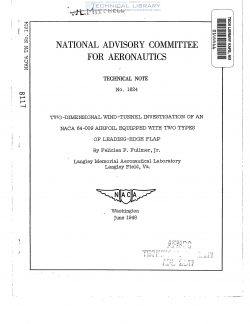naca-tn-1624
- Version
- 138 Downloads
- 1.13 MB File Size
- 1 File Count
- December 4, 2016 Create Date
- December 4, 2016 Last Updated
National Advisory Committee for Aeronautics, Technical Notes - Two Dimensional Wind Tunnel Investigation of an NACA 64-009 Airfoil Equipped with Two Types of Leading Edge Flap

An investigation was made to determine the effect of leading—edge
flaps on the maximum lift coefficient of an NAGA 611—009 airfoil and to
compare the results with data obtained from previous tests of similarly
shaped flaps on an NACA 6111—012 airfoil (NACA am No. 1277). The
investigation included tests of twolO—percent—chord leading—edge flaps,
one intended to slide forward along the upper surface and the other
hinged at the center of the airfoil leading-edge radius and deflecting
from the lower surface. The flaps were tested on the plain airfoil and
on the airfoil with a trailing—edge split flap deflected 60°. Data are
given to show the section lift characteristics for a range of flap
deflection and the section pitching—moment and lift characteristics
with leading—edge roughness for the optimum flap arrangements.
The results indicate that the upper—surface leading—edge flap was,
in general, a more effective high—lift device than the lower—surface
leading—edge flap, especially when used alone on the plain airfoil. A
leading—edge flap of a given size and shape was found to be capable,
in general, of producing (for approx. equal amounts of effective camber)
the same or slightly greater increments in the maximum lift coefficient
when attached to the 9—percent—thick airfoil rather than to the
lE—percent—thick airfoil.
In addition, it was found that deflecting either type of leading—
edge flap resulted in a forward movement of the aerodynamic center at
high angles of attack. With regard to the effects of surface roughness,
the upper—surface leading—edge flap was equally as good as the lower—
surface leading—edge flap even though the decrement in maximzm section
lift coefficient due to roughness was larger for the upper-surface
leading—edge—flap arrangement.
The problem of obtaining adequate maximum lift coefficients on
highly swept wings has shown the need for a more thorough investigation
of all types of leading—edge auxiliary high-lift devices. Considerable
interest has recently developed in one of these devices, the leading—
edge flap, because it has possibilities as a high—lift device for use
on highly swept wings, for any wing on which the normal trailing—edge
high—lift devices are ineffective, or for thin wings on which the proven
types of high—lift devices cannot be installed because of limited
thickness near the trailing edge.
| File | Action |
|---|---|
| naca-tn-1624 Two Dimensional Wind Tunnel Investigation of an NACA 64-009 Airfoil Equipped with Two Types of Leading Edge Flap.pdf | Download |

Comment On This Post